Just type your question
Thank you for your message
THE SERIES
My Borders
This series of artworks is about our boundaries. What do we allow ourselves to do? What do we allow others to do to us? What are our personal boundaries?
In particular I want to talk here about the retrospective of women's boundaries. In our still very patriarchal world, being a woman is harder and more dangerous. Yes the status of women has gotten better, but we can't talk about equality. The statistics of women in leadership positions and women suffering from violence contradict this. We still accept the roles we are allowed to play. If a woman finds herself more muscular and her identity doesn't match the imposed norm, then that behavior is considered deviant and unacceptable.
In particular I want to talk here about the retrospective of women's boundaries. In our still very patriarchal world, being a woman is harder and more dangerous. Yes the status of women has gotten better, but we can't talk about equality. The statistics of women in leadership positions and women suffering from violence contradict this. We still accept the roles we are allowed to play. If a woman finds herself more muscular and her identity doesn't match the imposed norm, then that behavior is considered deviant and unacceptable.
Only the emasculated image of a beautiful woman who is also a mother, a worker and a housekeeper is not antagonized by the world. Any other options are condemned. It is too many roles for one person. Mandatory family care prevents women from building a career. And modern beauty standards force women to undergo dangerous surgeries. The bottom line is that women aren't running forward to progress, they're running in circles and at each circle they have to manage to do more and more.
This series will be updated with new works. I still have unspoken thoughts about it.
This series will be updated with new works. I still have unspoken thoughts about it.
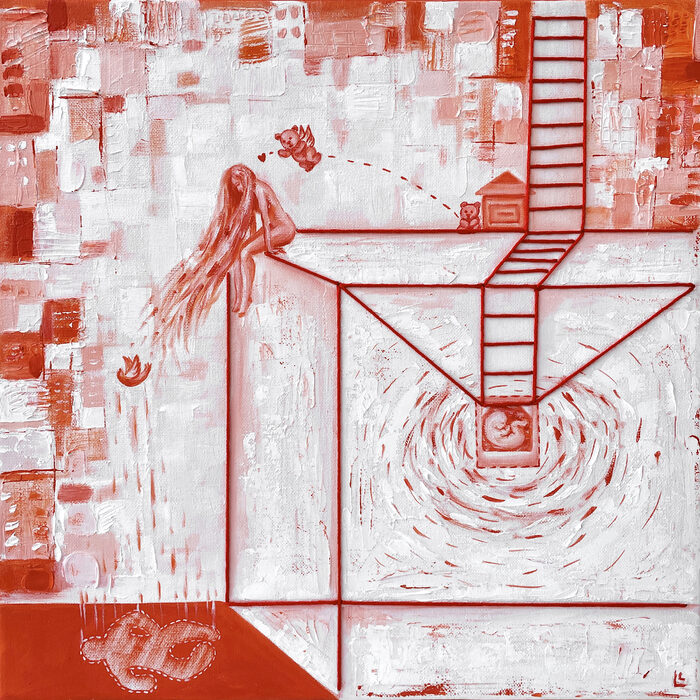
On the Edge of Herself
Mix media
(oil, texture paste, thread) on canvas, 40x40 cm
(oil, texture paste, thread) on canvas, 40x40 cm
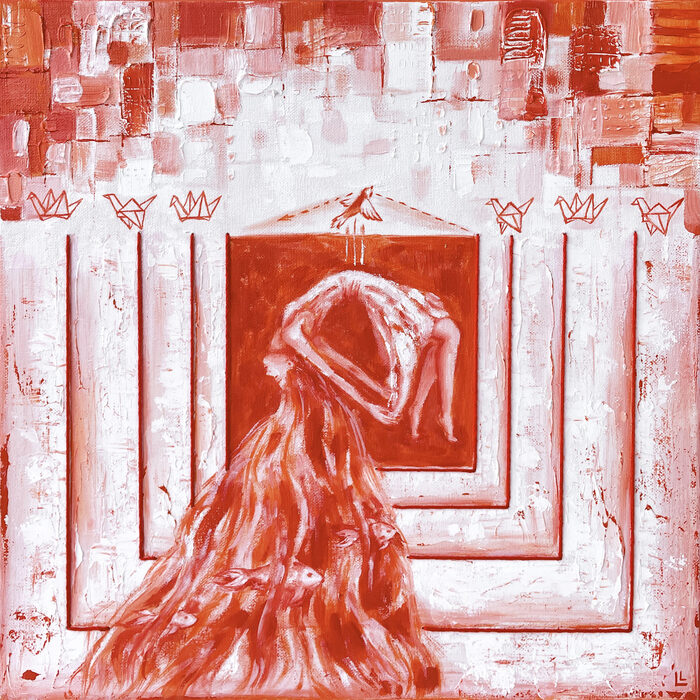
Accepting the Inevitable
Mix media
(oil, texture paste, thread) on canvas, 40x40 cm
(oil, texture paste, thread) on canvas, 40x40 cm
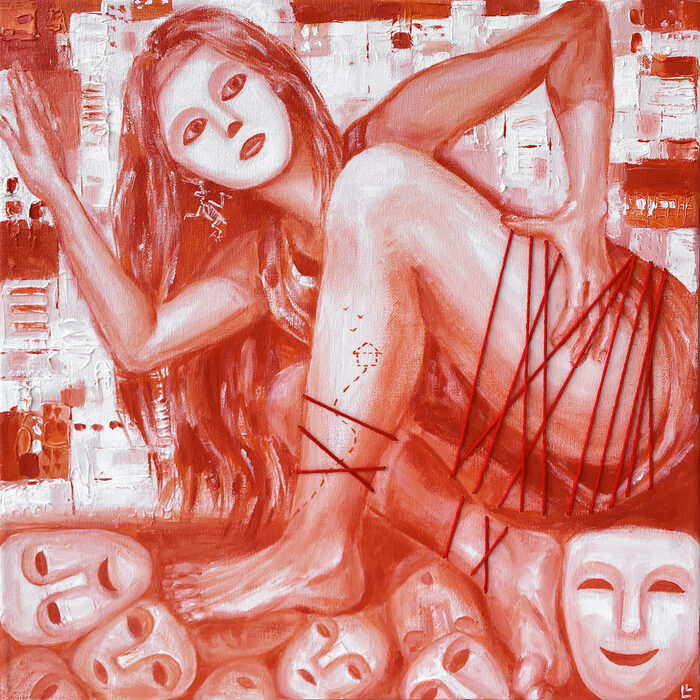
Uncontained
Mix media
(oil, texture paste, thread) on canvas, 40x40 cm
(oil, texture paste, thread) on canvas, 40x40 cm
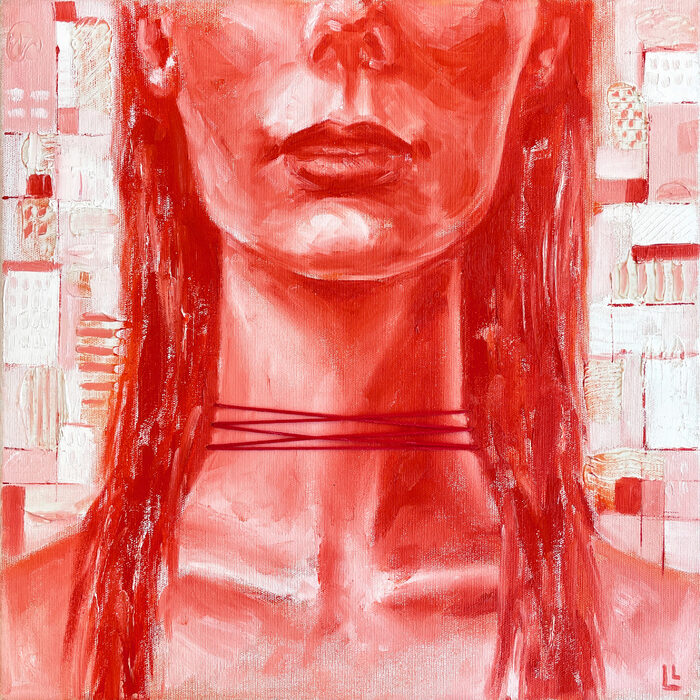
Breath
Mix media
(oil, texture paste, thread) on canvas, 40x40 cm
(oil, texture paste, thread) on canvas, 40x40 cm
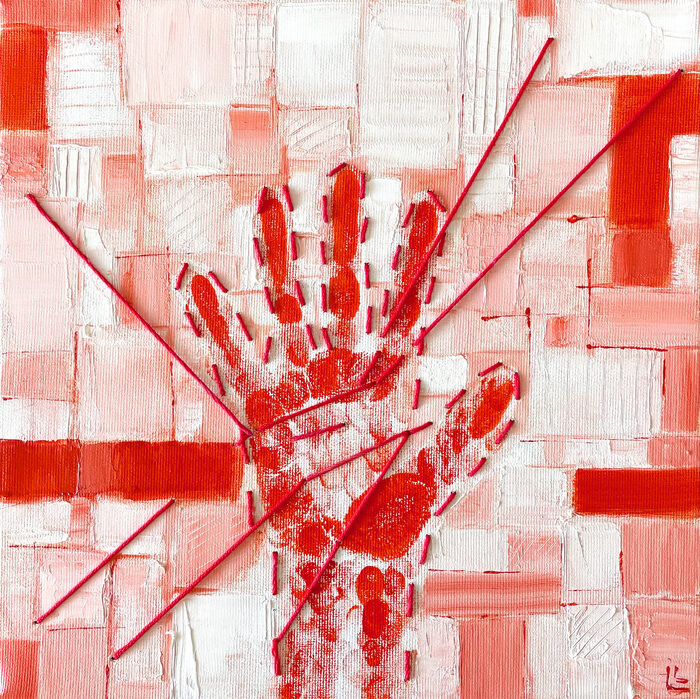
Personal borders
Mix media
(oil, texture paste, thread) on canvas, 30x30 cm
(oil, texture paste, thread) on canvas, 30x30 cm
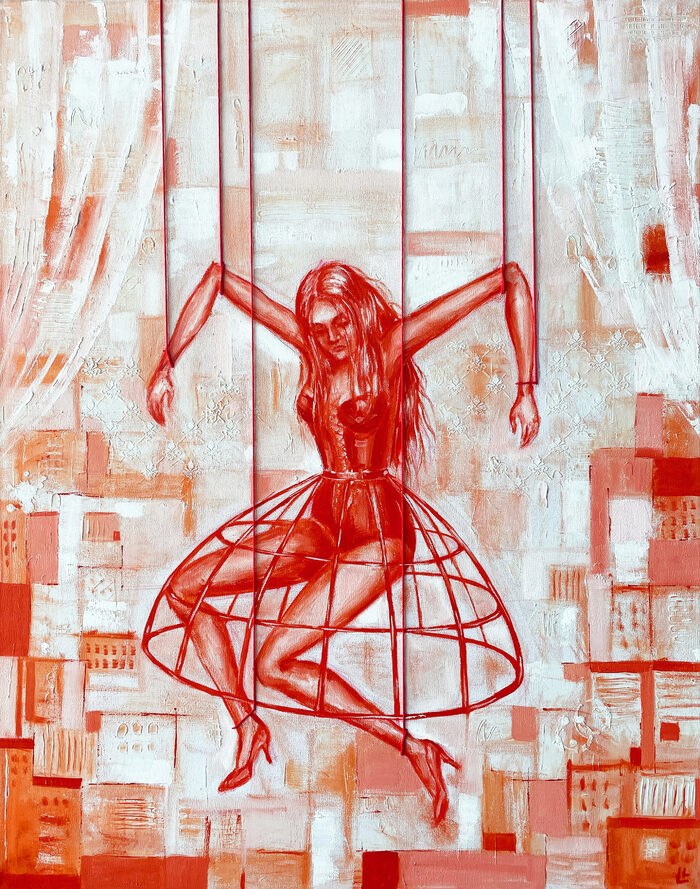
Puppet Doll
Mix media
(oil, texture paste, thread) on canvas, 70x90 cm
(oil, texture paste, thread) on canvas, 70x90 cm

Dangerous Standards
Installation, mix media
(nylon, thread, soft filler, acrylic, measuring tape, concrete, shoe) on canvas, 23x65x17 cm
(nylon, thread, soft filler, acrylic, measuring tape, concrete, shoe) on canvas, 23x65x17 cm
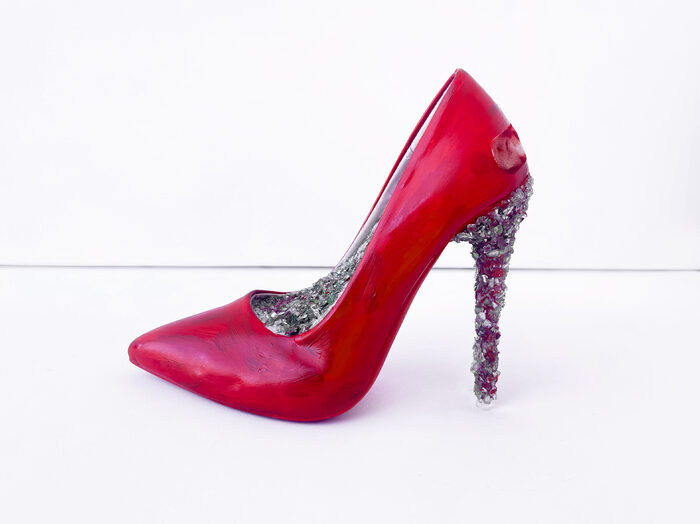
The Weight of Beauty
Installation, mix media
(shoe, acrylic, concrete, glass, adhesive tape), 23x18x9 cm
(shoe, acrylic, concrete, glass, adhesive tape), 23x18x9 cm
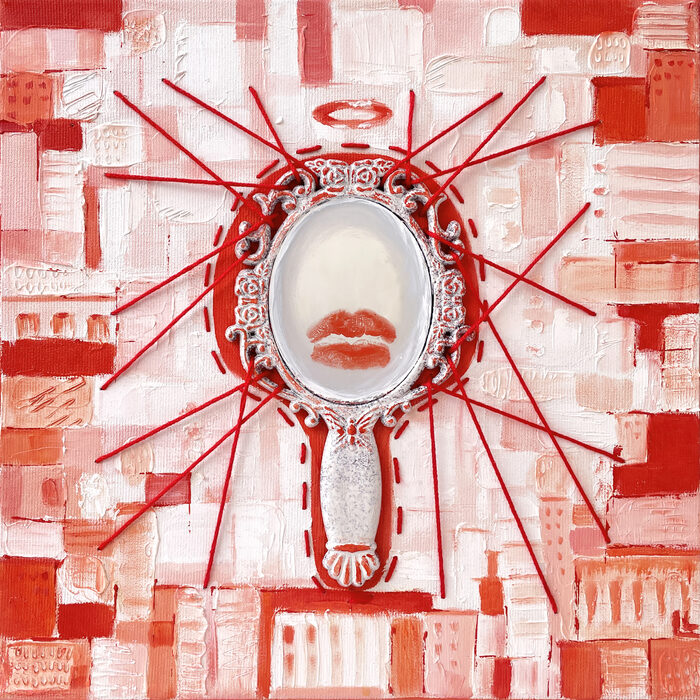
The Mirror of Expectations
Mix media
(oil, texture paste, thread) on canvas, 30x30 cm
(oil, texture paste, thread) on canvas, 30x30 cm
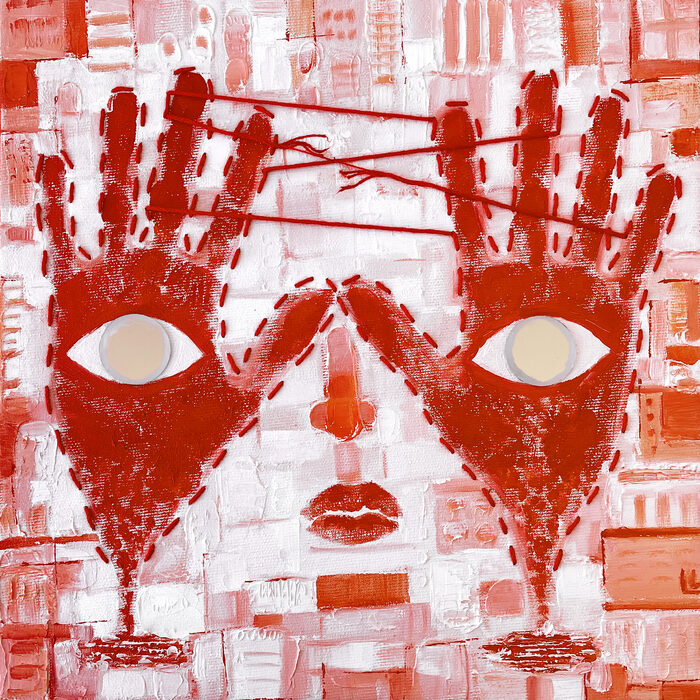
Through Her Own Eyes
Mix media
(oil, texture paste, thread) on canvas, 30x30 cm
(oil, texture paste, thread) on canvas, 30x30 cm
Concept art for this series

Digital artwork "Woman, Who Are You?"
This artwork is about a woman - her destiny, her choices.
Once, Malevich’s Black Square was a revolution that changed painting forever. Here, a Red Square emerges, composed of women whose names need no introduction: women who reshaped the world. (Frida Kahlo, Anna Akhmatova, Coco Chanel, Queen Elizabeth II, Golda Meir, Valentina Tereshkova, Serena Williams, Maria Skłodowska-Curie, Margaret Thatcher, Margaret Hamilton, Sofia Ionescu, Malala Yousafzai.)
At first glance, the square seems complete. But in its center, something disrupts its integrity, a missing link, a broken pixel on the screen of history. It flickers with uncertainty, with absence. Here stands the portrait of a modern young woman. Her face is veiled by an expensive platinum mask - an emblem of today’s beauty standards. She has almost merged with it, yet traces of individuality still remain. The mask is both her shield and her altar, concealing her identity while demanding devotion.
Because beauty has become a new religion, one that molds its followers into uniform clones, each more like a clown than the last. The spectacle resembles a grand circus: instead of fighting for real achievements, women wage a futile war against time. They armor themselves with the latest advancements in plastic surgery and cosmetology, transforming into assembly-line soldiers of beauty - constructed from artificial nails, hair extensions, eyelashes, breast implants, and sculpted features. No effort is spared in this endless battle.
The girl in the center turns to the women before her and asks:
Who are you? Will you leave a mark on history, or will you be just another flawless image on Instagram? Will you complete this red square with your presence, becoming someone truly significant to yourself and the world? Or will you surrender to the beauty industry’s doctrine, allowing the platinum mask to gradually erase you?
Once, Malevich’s Black Square was a revolution that changed painting forever. Here, a Red Square emerges, composed of women whose names need no introduction: women who reshaped the world. (Frida Kahlo, Anna Akhmatova, Coco Chanel, Queen Elizabeth II, Golda Meir, Valentina Tereshkova, Serena Williams, Maria Skłodowska-Curie, Margaret Thatcher, Margaret Hamilton, Sofia Ionescu, Malala Yousafzai.)
At first glance, the square seems complete. But in its center, something disrupts its integrity, a missing link, a broken pixel on the screen of history. It flickers with uncertainty, with absence. Here stands the portrait of a modern young woman. Her face is veiled by an expensive platinum mask - an emblem of today’s beauty standards. She has almost merged with it, yet traces of individuality still remain. The mask is both her shield and her altar, concealing her identity while demanding devotion.
Because beauty has become a new religion, one that molds its followers into uniform clones, each more like a clown than the last. The spectacle resembles a grand circus: instead of fighting for real achievements, women wage a futile war against time. They armor themselves with the latest advancements in plastic surgery and cosmetology, transforming into assembly-line soldiers of beauty - constructed from artificial nails, hair extensions, eyelashes, breast implants, and sculpted features. No effort is spared in this endless battle.
The girl in the center turns to the women before her and asks:
Who are you? Will you leave a mark on history, or will you be just another flawless image on Instagram? Will you complete this red square with your presence, becoming someone truly significant to yourself and the world? Or will you surrender to the beauty industry’s doctrine, allowing the platinum mask to gradually erase you?
